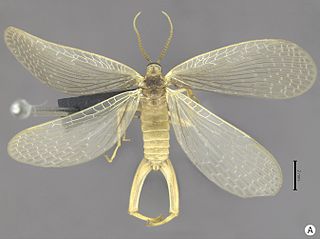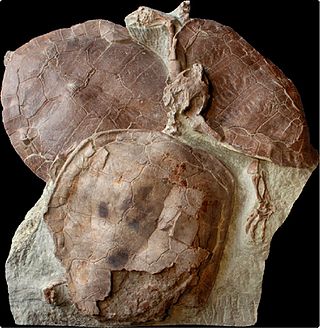
Flea, the common name for the order Siphonaptera, includes 2,500 species of small flightless insects that live as external parasites of mammals and birds. Fleas live by ingesting the blood of their hosts. Adult fleas grow to about 3 millimetres long, are usually brown, and have bodies that are "flattened" sideways or narrow, enabling them to move through their hosts' fur or feathers. They lack wings; their hind legs are extremely well adapted for jumping. Their claws keep them from being dislodged, and their mouthparts are adapted for piercing skin and sucking blood. Some species can leap 50 times their body length, a feat second only to jumps made by another group of insects, the superfamily of froghoppers. Flea larvae are worm-like, with no limbs; they have chewing mouthparts and feed on organic debris left on their hosts' skin.

Mecoptera is an order of insects in the superorder Holometabola with about six hundred species in nine families worldwide. Mecopterans are sometimes called scorpionflies after their largest family, Panorpidae, in which the males have enlarged genitals raised over the body that look similar to the stingers of scorpions, and long beaklike rostra. The Bittacidae, or hangingflies, are another prominent family and are known for their elaborate mating rituals, in which females choose mates based on the quality of gift prey offered to them by the males. A smaller group is the snow scorpionflies, family Boreidae, adults of which are sometimes seen walking on snowfields. In contrast, the majority of species in the order inhabit moist environments in tropical locations.

Tanyderidae, sometimes called primitive crane flies, are long, thin, delicate flies with spotted wings, superficially similar in appearance to some Tipulidae, Trichoceridae, and Ptychopteridae. Most species are restricted in distribution. They are found in many parts of the world, including North America, South America, Africa, Australia, New Zealand, and various islands in the Pacific Ocean. Adults are usually found hanging from vegetation near streams. Larvae are found either in sandy stream margins or in wet, rotten wood. Fossil species are known.

Meropeidae is a family of tiny scorpionflies within the order Mecoptera with only three known living species, commonly referred to as "earwigflies", based on the earwig-like forceps-shaped male genitalia. The living species are the North American Merope tuber, the Western Australian Austromerope poultoni, and the recently discovered South American A. brasiliensis. The biology of these species is essentially unknown, and their larvae have never been seen. The adults have been suggested to probably be saprophagous, though they have never been observed feeding. The fossil record of the group extends back to the Jurassic. The earliest known member is Boreomerope antiqua known from an isolated wing found in the Middle Jurassic Itat Formation of Siberia. Other extinct genera include Burmomerope with three species and Torvimerope with one species are both from the mid Cretaceous (Cenomanian) aged Burmese amber. As such, the extant members of this family can be considered living fossils. These insects are also of interest due to their presumed basal position in the order Mecoptera. Thaumatomerope with four described species all from the Madygen Formation in Kyrgyzstan has historically sometimes been included within the family, it was placed into its own monotypic family, "Thaumatomeropidae." in 2002.

Bittacidae is a family of scorpionflies commonly called hangingflies or hanging scorpionflies.

Boreidae, commonly called snow scorpionflies, or in the British Isles, snow fleas are a very small family of scorpionflies, containing only around 30 species, all of which are boreal or high-altitude species in the Northern Hemisphere.

Eomeropidae is a family of aberrant, flattened scorpionflies represented today by only a single living species, Notiothauma reedi, known from the Nothofagus forests in southern Chile, while all other recognized genera in the family are known only as fossils, with the earliest definitive fossil known from Liassic-aged strata, and the youngest from Paleogene-aged strata.

The Cryptobranchoidea are a suborder of salamanders found in Asia, European Russia, and the United States. They are known as primitive salamanders, in contrast to Salamandroidea, the advanced salamanders. It has two living subdivisions, Cryptobranchidae, and Hynobiidae, commonly known as Asian salamanders.

The Perissommatidae are a family of flies (Diptera) that was proposed in 1962 by Donald Colless based on the species Perissomma fusca from Australia. The family now includes five extant species within the single genus Perissomma, four from Australia and one from Chile. The Perissommatidae are unusual as they appear to have four compound eyes. They have a small slender body less than 2 mm in length. Their wings are large in comparison to their bodies and subsequently their flight is weak. Preferring high-altitude forest environments, adults only fly in the winter. The larvae live in decaying leaf litter in wet sclerophyll or cool rain forests. Some species are suspected to be associated with fungi. In the case of Perissomma macalpinei, numbers of adults have been observed congregating in clumps of foliage and rising in short, zigzag flights in the sunlight above the foliage for short periods before descending.

Coptoclavidae is an extinct family of aquatic beetles in the suborder Adephaga. The Coptoclavidae lived from the Late Triassic to the Early Cretaceous. Coptoclavidae is a member of the adephagan clade Dytiscoidea, which contains other aquatic beetles. Suggested reasons for their extinction to include the rise of teleost fish, or competition with Gyrinidae and Dytiscidae, which possess defensive secretions and sucking channels in the mandibles of larvae, which coptoclavids likely lacked. It has been suggested that the genus Timarchopsis and the subfamily Timarchopsinae are only distantly related to other coptoclavids based on cladistic analysis, with Timarchopsis being more closely related to geadephagans like carabids and trachypachids instead. Another study also suggested similarly for Coptoclavisca and possibly other coptoclaviscines.

Panorpida or Mecopterida is a proposed superorder of Holometabola. The conjectured monophyly of the Panorpida is historically based on morphological evidence, namely the reduction or loss of the ovipositor and several internal characteristics, including a muscle connecting a pleuron and the first axillary sclerite at the base of the wing, various features of the larval maxilla and labium, and basal fusion of CuP and A1 veins in the hind wings. The monophyly of the Panorpida is supported by recent molecular data.
Platycrossos is an extinct genus of protocoleopteran beetles in the family Permosynidae. It is known from the Triassic and Jurassic of Australia, Austria, Mongolia and Russia. Like other members of the family, the species of this genus were described from fossils of isolated elytra with punctate striae.

Xinjiangchelyidae is an extinct family of turtles known from the Lower Jurassic to the Middle Cretaceous of Asia and western Europe. They have generally been interpreted as either being basal cryptodires or placed outside of crown Testudines.
The Progonocimicidae are an extinct family of true bugs in the suborder Coleorrhyncha. Progonocimicidae fossils have been found in Europe, Asia, Australia, and South America.

Aneuretopsychidae is an extinct family of scorpionflies known from the Mesozoic. Fossils are known from the Jurassic (Callovian-Oxfordian) to the early Late Cretaceous (Cenomanian). It is part of Mesopsychoidea, a group of scorpionflies with siphonate proboscis. They are suggested to have been nectarivores, feeding off the liquid pollination drops of and acting as pollinators for now extinct insect pollinated gymnosperms such as Bennettitales.

Mesopsychidae is an extinct family of scorpionflies known from the Late Permian to Mid Cretaceous. It is part of Mesopsychoidea, a group of scorpionflies with siphonate proboscis. They are suggested to have been nectarivores, feeding off the liquid pollination drops and acting as pollinators for now extinct insect pollinated gymnosperms such as Bennettitales.
Austropanorpa is an extinct genus of scorpionfly. It is the only member of the family Austropanorpidae. The type species, A. australis was described by Edgar Riek in 1952 based on two incomplete forewings from the Redbank Plains Formation of Queensland, of probable Eocene age, and was assigned to Panorpidae. Later, it was recognised as distinctive enough to be assigned to its own monotypic family by Rainer Willman in 1977. In 2018 the species "Orthophlebia" martynovae from the Early Jurassic (Toarcian) aged Cheremkhovo Formation near Lake Baikal in Siberia, described by Irina Sukacheva in 1985, was recognised as belonging to the genus. The genus is distinguished from other mecopterans by having nine branched radial sectors and four veins in the medial sector of both wings, as opposed to living panorpoids which are typically 5 and rarely 6 branched.

Necrotauliidae is an extinct family Mesozoic Amphiesmenoptera. While previously considered a paraphyletic grouping of "basal Trichoptera, basal Lepidoptera, and advanced stem-Amphiesmenoptera", they have recently been considered early diverging caddisflies. Other authors have considered them to be basal amphiesiopterans.

Orthophlebiidae is an extinct family of scorpionflies known from the Triassic to Cretaceous, belonging to the superfamily Panorpoidea. The family is poorly defined and is probably paraphyletic, representing many primitive members of Panorpoidea with most species only known from isolated wings, and has such been considered a wastebasket taxon.
Archizelmiridae is an extinct family of flies, known from the Jurassic and Cretaceous periods. It belongs to the Sciaroidea, and has suggested to have a close relationship with Sciaridae.




















